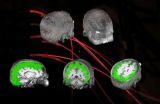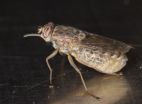(Press-News.org) A substantial proportion of risk for developing autism spectrum disorders (ASD), resides in genes that are part of specific, interconnected biological pathways, according to researchers from the Icahn School of Medicine at Mount Sinai, who conducted a broad study of almost 2,500 families in the United States and throughout the world. The study, titled "Convergence of Genes and Cellular Pathways Dysregulated in Autism Spectrum Disorders," was first published online in the American Journal of Human Genetics on April 24.
ASD affects about one percent of the population in the United States and is characterized by impairments in social interaction and communication, as well as by repetitive and restricted behaviors. ASD ranges from mild to severe levels of impairment, with cognitive function among individuals from above average to intellectual disability.
Previously, ASD has been shown to be highly inheritable, and genomic studies have revealed that that there are various sources of risk for ASD, including large abnormalities in whole chromosomes, deletions or duplications in sections of DNA – called copy number variants (CNVs), and even changes of single nucleotides (SNVs) within a gene; genes contain instructions to produce proteins that have various functions in the cell.
The researchers reported numerous CNVs affecting genes, and found that these genes are part of similar cellular pathways involved in brain development, synapse function and chromatin regulation. Individuals with ASD carried more of these CNVs than individuals in the control group, and some of them were inherited while others were only present in offspring with ASD.
An earlier study, results of which were first published in 2010, highlighted a subset of these findings within a cohort of approximately 1,000 families in the U.S. and Europe; this larger study has expanded that cohort to nearly 2,500 families, each comprising "trios" of two parents and one child. By further aggregating CNVs and SNVs (the latter identified in other studies), Mount Sinai researchers discovered many additional genes and pathways involved in ASD.
"We hope that these new findings will help group individuals with ASD based upon their genetic causes and lead to earlier diagnosis, and smarter, more focused therapies and interventions for autism spectrum disorders," said first author Dalila Pinto, PhD, Assistant Professor of Psychiatry, and Genetics and Genomic Sciences at the Icahn School of Medicine at Mount Sinai. Dr. Pinto is a Seaver Foundation Faculty Fellow, and a member of the Mindich Child Health & Development Institute, the Icahn Institute for Genomics and Multiscale Biology, and the Friedman Brain Institute at the Icahn School of Medicine at Mount Sinai; other Mount Sinai researchers on this study include Mafalda Barbosa, Graduate Student in Psychiatry; Xiao Xu, PhD, Postdoctoral Fellow in Psychiatry; Alexander Kolevzon, MD, Clinical Director of the Seaver Autism Center and Associate Professor of Psychiatry and Pediatrics; and Joseph D. Buxbaum, PhD, Director of the Seaver Autism Center, Vice Chair for Research in Psychiatry, and Professor of Psychiatry, Neuroscience, and Genetics and Genomic Sciences.
INFORMATION:
This study was jointly supported through the main funders of the International Autism Genome Project: Autism Speaks, the Health Research Board (Ireland), the Hillbrand Foundations, the Genome Canada, the Ontario Genomics Institute, and the Canadian Institutes of Health Research.
Genetic alterations in shared biological pathways as major risk factor for ASD
Mount Sinai study published in American Journal of Human Genetics
2014-04-24
ELSE PRESS RELEASES FROM THIS DATE:
Controlling brain waves to improve vision
2014-04-24
Have you ever accidently missed a red light or a stop sign? Or have you heard someone mention a visible event that you passed by but totally missed seeing?
"When we have different things competing for our attention, we can only be aware of so much of what we see," said Kyle Mathewson, Beckman Institute Postdoctoral Fellow at the University of Illinois. "For example, when you're driving, you might really be concentrating on obeying traffic signals."
But say there's an unexpected event: an emergency vehicle, a pedestrian, or an animal running into the road—will you actually ...
Computer program could help solve arson cases
2014-04-24
Sifting through the chemical clues left behind by arson is delicate, time-consuming work, but University of Alberta researchers teaming with RCMP scientists in Canada, have found a way to speed the process.
A computer program developed by University of Alberta chemistry professor James Harynuk, his team of graduate and undergraduate researchers and the Royal Canadian Mounted Police National Forensic Laboratory Services, can cut the need for extra levels of human analysis, reducing the waiting time to find out the cause of a deliberately set fire.
That means quicker ...
'Horsing around' reduces stress hormones in youth
2014-04-24
PULLMAN, Wash. – New research from Washington State University reveals how youth who work with horses experience a substantial reduction in stress – and the evidence lies in kids' saliva.
The results are published in the American Psychological Association's Human-Animal Interaction Bulletin this month.
Pendry-80"We were coming at this from a prevention perspective," said Patricia Pendry, a developmental psychologist at WSU who studies how stress "gets under the skin" and the effects of prevention programs on human development. "We are especially interested in optimizing ...
JCI online ahead of print table of contents for April 24, 2014
2014-04-24
Ex vivo expansion of hematopoietic stem cells from cord blood
Compared to hematopoietic stem cells (HSCs) isolated from adults, HSCs isolated from cord blood (CB) have enhanced proliferative potential and can lead to hematological reconstitution when engrafted in children with hematological malignancies or genetic defects. Unfortunately, small numbers of HSCs are present in single CB collections, limiting their use as grafts for adults. For several decades investigators have used a variety of strategies to expand the numbers of CB HSC ex vivo with limited success. Evidence ...
Microscopic organism plays a big role in ocean carbon cycling, Scripps scientists discover
2014-04-24
It's broadly understood that the world's oceans play a crucial role in the global-scale cycling and exchange of carbon between Earth's ecosystems and atmosphere. Now scientists at Scripps Institution of Oceanography at UC San Diego have taken a leap forward in understanding the microscopic underpinnings of these processes.
When phytoplankton use carbon dioxide to make new cells, a substantial portion of that cellular material is released into the sea as a buffet of edible molecules collectively called "dissolved organic carbon." The majority of these molecules are eventually ...
What makes psychotic teens more at risk for suicide than other groups with psychosis?
2014-04-24
Suicide is a general risk for people with psychosis. According to the Journal of Psychiatry, 20 percent to 40 percent of those diagnosed with psychosis attempt suicide, and up to 10 percent succeed.
And teens with psychotic symptoms are nearly 70 times more likely to attempt suicide than adolescents in the general population, according to a 2013 study in JAMA Psychiatry.
But what contributes to such high numbers?
Jane Timmons-Mitchell, PhD, from Case Western Reserve University's social work school, and Tatiana Falcone, MD, from the Cleveland Clinic, reviewed studies ...
Solving the mystery of a superluminous supernova
2014-04-24
This release is available in Japanese.
An exceptionally bright supernova reported in 2013 is so luminous, a new study reports, because a lens in the sky amplified its light. The discovery of the lens settles an important controversy in the field of astronomy.
In 2010, a team of scientists observed a supernova, PS1-10afx, shining brighter than any other in its class.
"PS1-10afx is like nothing we have seen before," said senior author Robert Quimby of the University of Tokyo's Kavli Institute for the Physics and Mathematics of the Universe.
Its exceptional glow ...
A scourge of rural Africa, the tsetse fly is genetically deciphered
2014-04-24
New Haven, Conn. – An international team of researchers led by the Yale School of Public Health has successfully sequenced the genetic code of the tsetse fly, opening the door to scientific breakthroughs that could reduce or end the scourge of African sleeping sickness in sub-Saharan Africa. The study is published in the journal Science.
It took nearly 10 years and more than 140 scientists from numerous countries to map the genome of the fly, also known as Glossina morsitans. Tsetse flies are the sole insect vectors of a disease that threatens the health of millions ...
Breakthrough harnesses light for controlled chemical reaction
2014-04-24
MADISON – When chemist Tehshik Yoon looks out his office window, he sees a source of energy to drive chemical reactions. Plants "learned" to synthesize chemicals with sunlight eons ago; Yoon came to the field a bit more recently.
But this week, in the journal Science, he and three collaborators detail a way to use sunlight and two catalysts to create molecules that are difficult to make with conventional techniques.
In chemistry, heat and ultraviolet (UV) light are commonly used to drive reactions. Although light can power reactions that heat cannot, UV has disadvantages, ...
Researchers build new 'off switch' to shut down neural activity
2014-04-24
Nearly a decade ago, the era of optogenetics was ushered in with the development of channelrhodopsins, light-activated ion channels that can, with the flick of a switch, instantaneously turn on neurons in which they are genetically expressed. What has lagged behind, however, is the ability to use light to inactivate neurons with an equal level of reliability and efficiency. Now, Howard Hughes Medical Institute (HHMI) scientists have used an analysis of channelrhodopsin's molecular structure to guide a series of genetic mutations to the ion channel that grant the power to ...
LAST 30 PRESS RELEASES:
Study uncovers neural mechanisms underlying foraging behavior in freely moving animals
Gene therapy is halting cancer. Can it work against brain tumors?
New copper-catalyzed C-H activation strategy from Scripps Research
New compound from blessed thistle promotes functional nerve regeneration
Auburn’s McCrary Institute, ORNL to partner on first regional cybersecurity center to protect the nation’s electricity grid
New UNC-Chapel Hill study examines the increased adoption of they/them pronouns
Groundbreaking study reveals potential diagnostic marker for multiple sclerosis years before symptom onset
Annals of Internal Medicine presents breaking scientific news at ACP’s Internal Medicine Meeting 2024
Scientists discover new way to extract cosmological information from galaxy surveys
Shoe technology reduces risk of diabetic foot ulcers
URI-led team finds direct evidence of ‘itinerant breeding’ in East Coast shorebird species
Wayne State researcher aims to improve coding peer review practices
Researchers develop a new way to safely boost immune cells to fight cancer
Compact quantum light processing
Toxic chemicals from microplastics can be absorbed through skin
New research defines specific genomic changes associated with the transmissibility of the monkeypox virus
Registration of biological pest control products exceeds that of agrochemicals in Brazil
How reflecting on gratitude received from family can make you a better leader
Wearable technology assesses surgeons’ posture during surgery
AATS and CRF® partner on New York Valves: The structural heart summit
Postpartum breast cancer and survival in women with germline BRCA pathogenic variants
Self-administered acupressure for probable knee osteoarthritis in middle-aged and older adults
2024 Communicator Award goes to “Cyber and the City” research team based in Tübingen
A new therapeutic target for traumatic brain injury
Cosmic rays streamed through Earth’s atmosphere 41,000 years ago
ACP issues clinical recommendations for newer diabetes treatments
New insights into the connections between alcohol consumption and aggressive liver cancer
Unraveling water mysteries beyond Earth
Signs of multiple sclerosis show up in blood years before symptoms
Ghost particle on the scales
[Press-News.org] Genetic alterations in shared biological pathways as major risk factor for ASDMount Sinai study published in American Journal of Human Genetics

